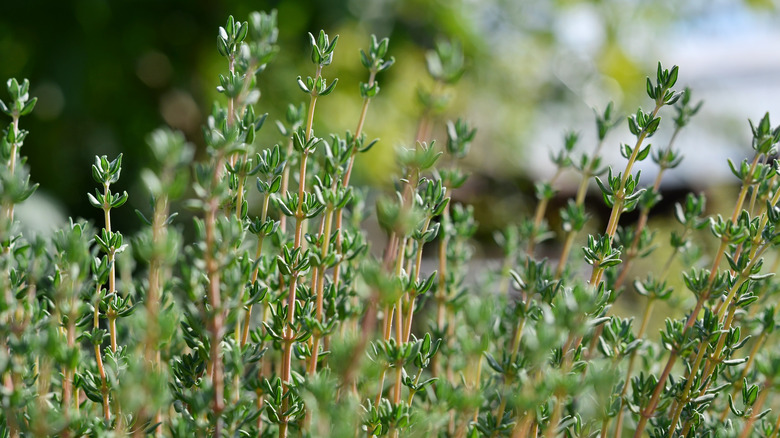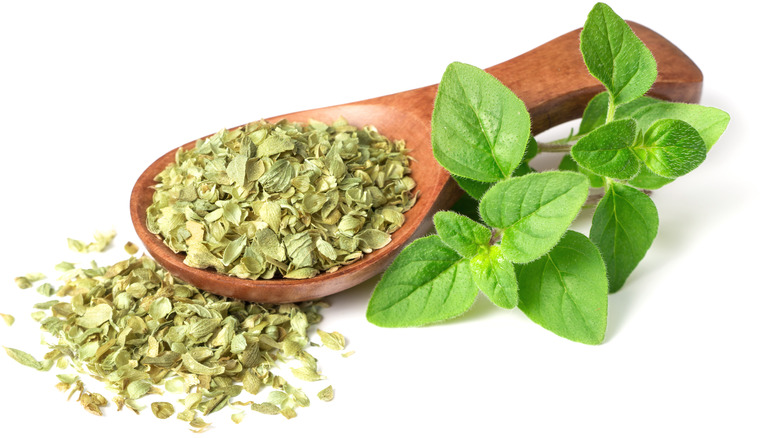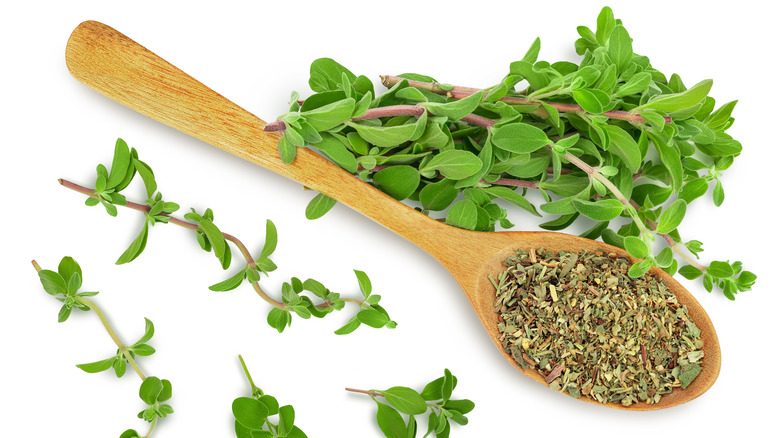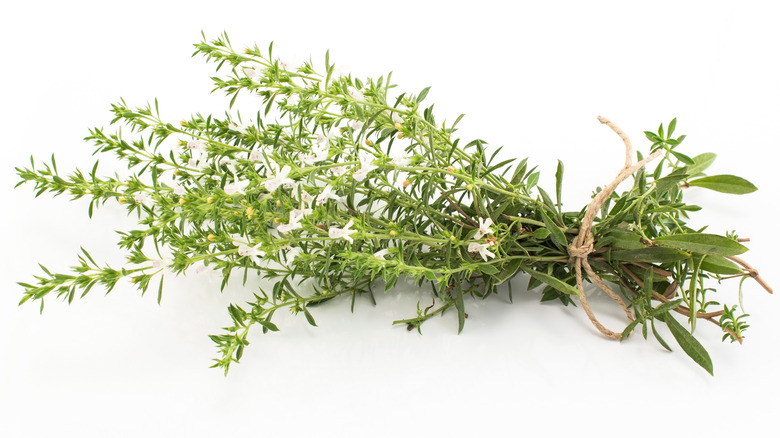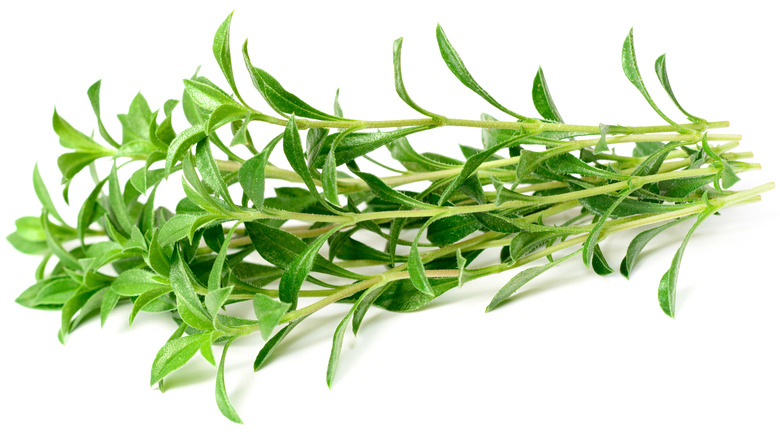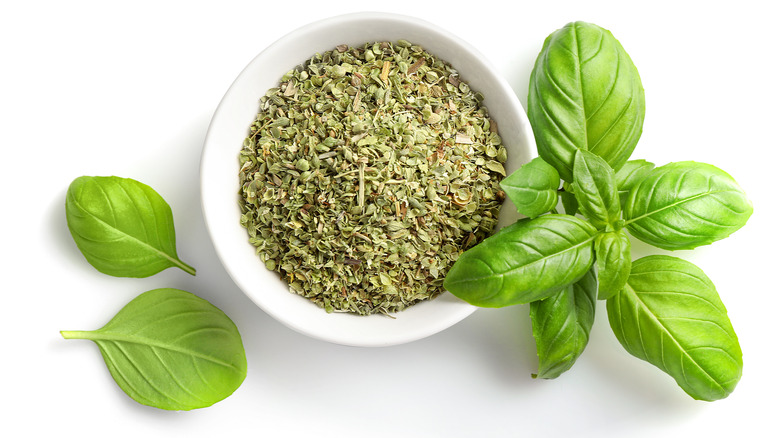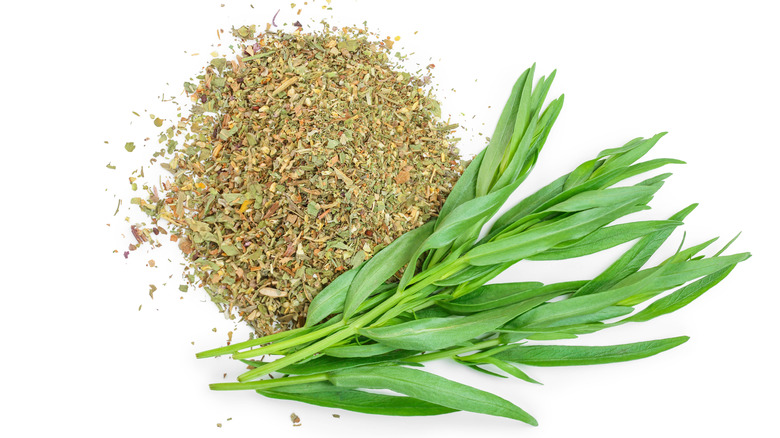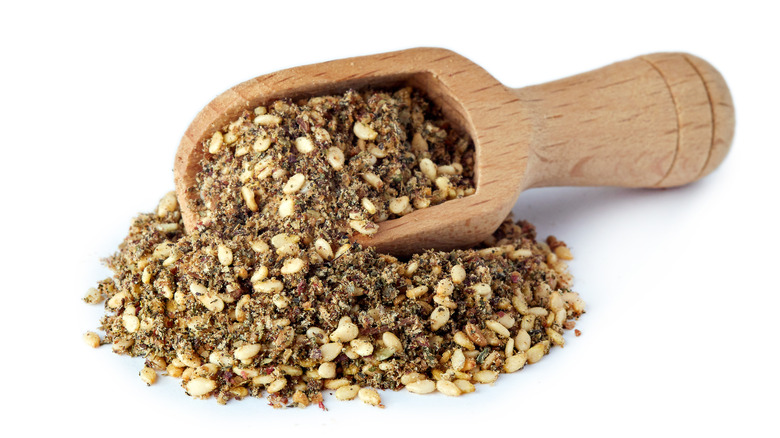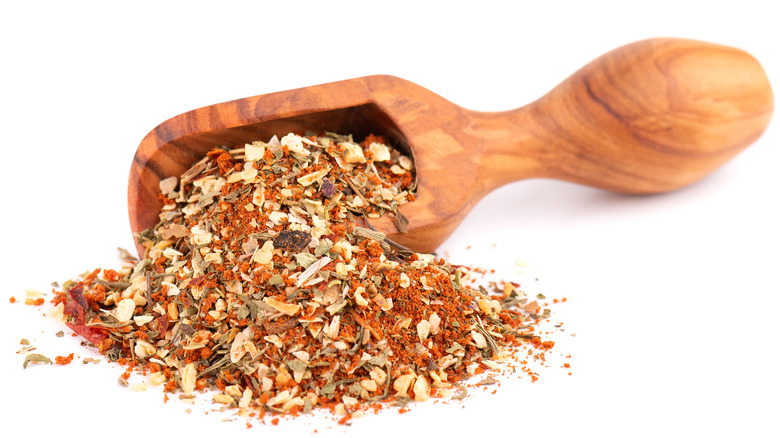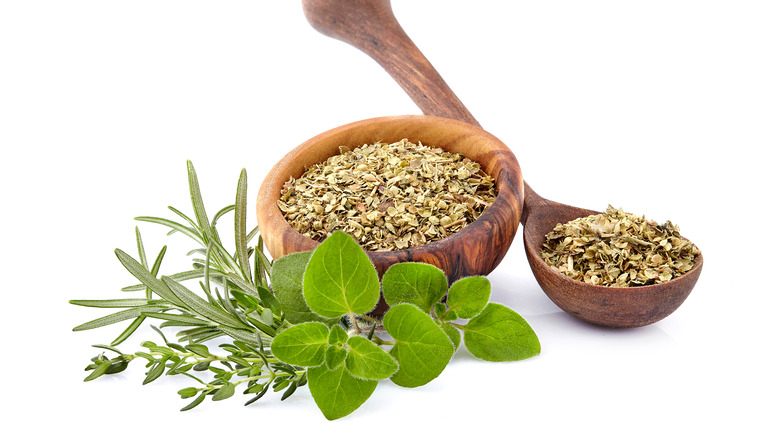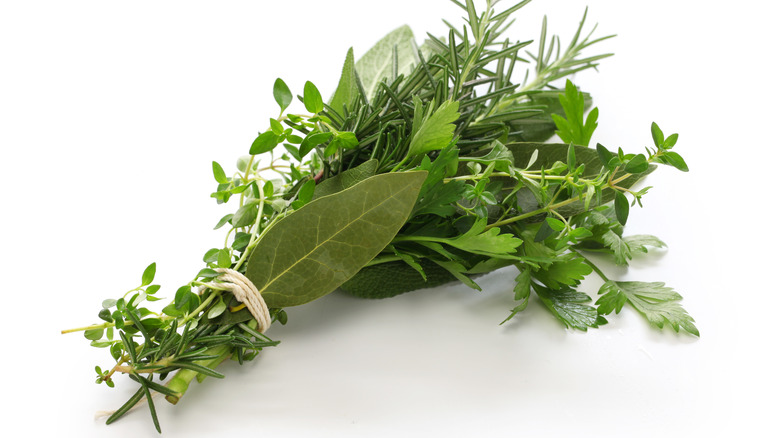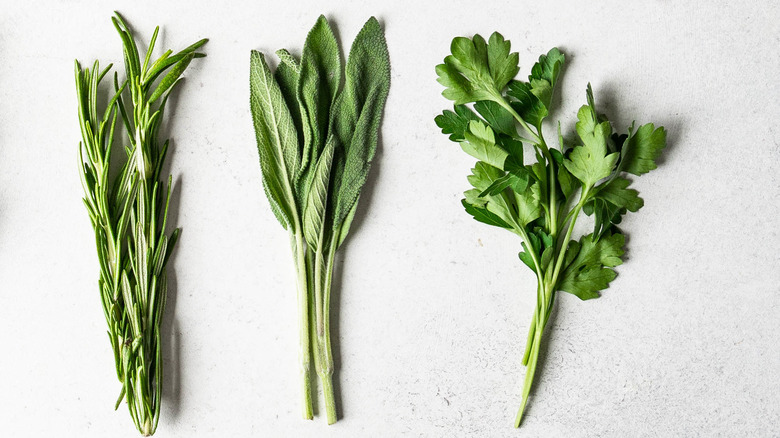Here's What You Can Substitute For Thyme
Thyme is a woody herb that belongs to the mint family. It's native to the Mediterranean and prominent in French, Spanish, and Portuguese cuisine (via Spice Advice). Flavorwise, the herb is incredibly versatile and has a unique and delicate taste. Somewhat clover-like and lightly minted with mild citrus notes, it lends itself to both sweet and savory culinary preparations (via Almanac). Outside the kitchen, thyme is commonly used to treat a number of ailments, per Medical News Today.
Whether fresh or dried, you might not always have the shrubby herb lying around. So what do you do if you are all out of thyme? Lucky for you, there are multiple herbs that can be substituted in a pinch. Many of them are kitchen staples that are also related to the mint family, while others are dried blends that contain thyme as an ingredient.
That being said, there are some herbs you definitely want to avoid, unless you're looking to severely sabotage your meal. Lastly, keep in mind the general rule of thumb when swapping dried and fresh herbs. According to Martha Stewart, stick to the ratio of 1 tablespoon of fresh herbs per 1 teaspoon of dried herbs (or vice versa).
Oregano
Whether it's fresh or dried, oregano is going to be your best stand-in if you're all out of thyme. Not only does this fragrant herb share some of its lineage, but it also has many overlapping flavors. Two varieties are typically found: Mediterranean (also known as Italian oregano) and Mexican oregano. According to Spices Inc., the former is part of the mint family whereas the latter comes from the vervain family.
The outlet notes that the Mexican variety tends to have a slightly earthier citrusy flavor. As such, you'll see it show up in Latin American cooking. Meanwhile, Mediterranean oregano gives an Italian vibe to whatever dish you're making. Just remember that oregano is incredibly potent and works best with dishes that can stand up to its bold aromatics. It goes well in a marinade but also lends a nice aroma and flavor profile to soups, sauces, and even bread.
If you're using oregano in the same form (fresh or dried) as the thyme required for your recipe, just use a one-to-one ratio. However, if you're swapping fresh for dried, use three parts to one part. If you want to tone down oregano's bolder qualities, stick with a two-to-one ratio. It's better to start with a little and move on from there.
Marjoram
This low-lying bushy Mediterranean herb is also part of the mint family (and thus a relative of thyme), so it's a suitable substitution since it shares the same minty undertones (via My Recipes). Marjoram has a woodsy, pine-like taste that is warm, sweet, and a tad bitter. It's commonly used in conjunction with other herbs to create aromatic blends such as herbes de Provence.
You'll find it in braises, soups, stews, and even preserved meats like German sausage (via MasterClass). You can also consume it as a tea for its various beneficial health properties (via Slurrp). Per a 2017 study published in the Journal of Evidence-Based Complementary & Alternative Medicine, marjoram was documented as being high in both vitamins A and C and was shown to help alleviate inflammation, pain, and digestive issues.
Unlike other herbs, marjoram retains much of its flavor during the dehydration process, so it's easy to use in both its dried and fresh forms. Use the standard one-to-one swap out if your recipe uses dried thyme (the same goes for using fresh). If your recipe calls for fresh thyme and you only have dried marjoram, simply use half the amount of marjoram. On the flip side, if you only have fresh marjoram and your recipe calls for dried thyme, use twice as much fresh marjoram.
Summer Savory
Savory is yet another member of the mint family that is native to Northwest America (via Kitchn) and the Mediterranean, per MasterClass. The outlet adds that it was once thought to be an aphrodisiac back in ancient Rome. The versatile herb can be used in a multitude of dishes just like thyme, and it also bears a similar taste profile — sweet, spicy, and aromas combining thyme, mint, and marjoram.
This shrubby green herb tends to be more delicate and lighter than its sibling winter savory and is commonly used in traditional and holiday dishes along the Atlantic Canadian coast (via MasterClass). You can use summer savory in just about any dish that requires thyme as an ingredient. You'll notice that it easily enhances vegetable dishes, spreads, lamb, and stuffing.
Since it tastes so much like thyme, you can follow a one-to-one ratio if you're replacing dried with dried or fresh with fresh. Meanwhile, if you're substituting fresh for dried, use a two-to-one approach and the opposite for switching out dried to fresh.
Winter Savory
Unlike its sibling, winter savory is earthier and more muted in flavor though it still has similar notes to thyme, marjoram, and mint. It also has a warmer taste that somewhat hints at sage. The winter savory plant is woodier than its summery sibling (via Mountain Valley Growers) and tends to be used after summer savory has been cut back. It is also indigenous to the Mediterranean, where it can be found growing in the nooks and crannies of craggy ledges (via MasterClass).
Winter savory makes a great addition to vegetable dishes that are rather odoriferous (think cabbage and onions) because it disguises the smell (via Harvest to Table). Game meats such as venison, rabbit, or wild poultry, as well as pork, trout, and hearty winter vegetables like kale, beets, mushrooms, potatoes, and turnips can all benefit from a bit of winter savory. If you're worried about your salt consumption or are just looking to cut back, take a note from the ancient Romans — they were known to use savory in place of salt (per MasterClass).
Follow the same ratios used for winter savory's warm-weather sun-loving sibling.
Basil
Basil is part of the thyme family, so it can be a potential substitute. Its taste can be described as sweet, bright, fresh, and a bit peppery, with undertones of mint and anise (via MasterClass). It's a versatile herb that lends itself to both sweet and savory dishes, just like its relative thyme. That being said, basil actually tastes quite different in its fresh versus dried states.
The Spruce Eats notes that fresh basil is ideal for cooking as it has a brighter flavor. Meanwhile, dried basil has a mintier flavor due to the dehydration step it undergoes. As such, you will need to be careful with the ratios you use depending on the desired flavor profile. Mint and shrimp don't necessarily go together — anise and shrimp are a better match.
Kitchn explains that fresh herbs are mostly water (about 80 to 90%), whereas dehydrated herbs are basically a concentrated flavor bomb. Stick to a three-to-one ratio here: 1 tablespoon of fresh basil for 1 teaspoon of dried thyme and vice versa. If you're a little weary about possibly ruining your dish, remember that a little goes a long way. You can always add a pinch more after the fact.
Tarragon
Tarragon – aka the king of herbs (per Foodal) — is a fancy-sounding herb that automatically makes any dish appear to be far more upscale than it is. It isn't part of the mint family, unlike the previous herbs we've listed. But that doesn't mean this little green plant can't hold its own as a thyme substitute. While tarragon is a bit sweeter with a slightly more bitter profile than thyme, as described by Spiceography, its unique taste places it somewhere in the realm of anise, fennel, and black licorice.
Don't let that combination deter you. While it truly is a potent herb that should be used sparingly, its anise aromas are comparable to thyme's mint-like flavor, making it a suitable replacement. Tarragon is also a delicate herb, so it's recommended to use it fresh whenever possible.
Tarragon can be found in rich sauces like a classic Béarnaise (per Taste Atlas), in creamy salad dressings, and paired with meaty white fish like halibut. As with tarragon's other herbaceous buddies, if you're substituting fresh thyme for fresh tarragon, use a two-to-one ratio (or three-to-one if you're feeling gutsy). Meanwhile, if your recipe calls for dried thyme, opt for an equal amount of dried tarragon.
Za'atar
Za'atar is a Middle Eastern spice blend consisting of dried thyme, marjoram, oregano, sumac, toasted sesame seeds, and salt (via NPR). The mix can be sprinkled over hummus, stirred into assorted dips or dressings, used as a meat seasoning, or added to bread dough or pasta. It pretty much improves any savory dish.
Although thyme is a major component of the blend, it's important to keep in mind that sesame, sumac, and oregano also bring a lot of flavor to the table. Sesame is slightly nutty and sweet, while oregano is sweet, spicy, earthy, and a tad bitter, per MasterClass. Meanwhile, sumac is in a league of its own because it has very little aroma but adds an earthy citrusy tang (via Eater).
Even though za'atar has a lot of bold flavors, it's still considered to be a good substitute for thyme if you're out. You'll just want to use this blend sparingly because the sumac and sesame can overpower the other flavors in your dish. Za'atar sometimes contains salt as an ingredient, so be sure to read the label. If it does contain this flavor-enhancing mineral, you'll also want to reduce the amount you add to whatever you're cooking. Too much salt can make a dish go south pretty quickly.
Italian seasoning
Italian seasoning typically consists of dried basil, marjoram, thyme, oregano, and rosemary, which Food Network asserts is a suitable substitution for thyme. The blend has an earthy, savory, and somewhat sweet flavor, and doesn't usually contain any salt. It's a common assumption that Italian seasoning should mainly be used in Italian food, but it's time to stop the pigeonholing.
It's true that this fragrant blend helps take stewed tomatoes to the next level, but it has many other uses. Try adding it to breading to boost your fried chicken, combine it with garlic butter, or simply use it to elevate the flavor of different proteins. The origins of the herb mix are slightly confused, and while some sources suggest it comes from the Mediterranean region (per Paesana), others attribute it to Italian immigrants in the U.S. (via Spiceography).
Keep in mind that this is a basil and rosemary-forward blend, so it should be substituted in dishes that are more Italian or Mediterranean inspired, as opposed to cuisines that steer away from the two herbs. Start off with a little bit of Italian seasoning — about half the amount of thyme the recipe calls for — and add more to taste.
Poultry seasoning
Poultry seasoning should be considered one of the last resorts for thyme substitutions, specifically because it consists of an all-star cast of highly potent herbs ... and sometimes salt. While sage takes the lead, thyme plays a supporting role, followed by marjoram, rosemary, nutmeg, and black or white pepper (via Allrecipes).
Much like Italian seasoning, poultry seasoning is another blend that tends to be used only for poultry (makes sense, right?). Nonetheless, as per Kitchn, it will add plenty of depth to vegetable soups. Poultry seasoning will give your pork chops layers of flavor and add a homey essence to roasted vegetables. If you're wondering what it smells or tastes like, just think of Thanksgiving stuffing.
When it comes to subbing it in for thyme, just stick with the traditional one-to-one ratio for dried herb substitutions. However, remember to check and see if your poultry seasoning contains salt. If it does, use half the amount and add more poultry seasoning afterward if necessary. You want to avoid creating an aromatically overpowering and overwhelmingly salty dish.
Herbes de Provence
Herbes de Provence is a blend of dried herbs considered to be an essential component in the cuisine of Southeastern France where it hails from (via MasterClass). You'll find it pairs similarly well with other Mediterranean cuisines too. This fragrant blend was made famous internationally by culinary pioneer Julia Child in the 1970s. Its core ingredients are thyme, rosemary, parsley, fennel, marjoram, and tarragon. Some recipes also include basil, chervil, sage, oregano, bay leaf, mint, and even lavender.
Because thyme is a major player in herbes de Provence, the blend can be considered a good substitute ... for the most part. Remember, it also contains other big-flavor players like fennel, rosemary, and parsley, so use it sparingly. You'll want to reduce the one-to-one ratio and begin with half the amount of herbes de Provence and build up from there. Remember: You can always add more, but you can't remove seasoning!
Steer clear of sage, rosemary, and parsley
Just like oregano, marjoram, savory, and basil (not to mention lavender, catnip, lemon balm, and patchouli), sage and rosemary are both included in the mint family (via Britannica). However, that doesn't mean they have the same flavorful nuances. Sage is an evergreen shrub noted for bringing complex flavors to dishes and it has a rather potent (though comforting) aroma. It tastes earthy with mild citrus and pine undertones and goes well with poultry, meat, sausage, and pasta (via MasterClass).
Rosemary is another pleasantly pungent evergreen with a woody taste and a scent that's been compared to eucalyptus, lavender, and citrus. Be cautious in the kitchen as it can take on a mild bitterness if cooked too long, writes Thrive Cuisine. Rosemary is commonly used to season proteins like pork or chicken and it pairs well with root vegetables, beans, and bread.
Parsley isn't just a garnish to ignore. It's a slightly bitter, somewhat earthy, and peppery herb that's high in vitamin K, which helps increase your bone density and prevent fractures, per a 2001 study published in Nutrition. It's also one of the main components of tabbouleh. This leafy green has a pretty aggressive flavor profile compared to thyme, so if you should choose to use it as a substitute, it's recommended to pair it with marjoram, which holds onto those subtle thyme nuances.
